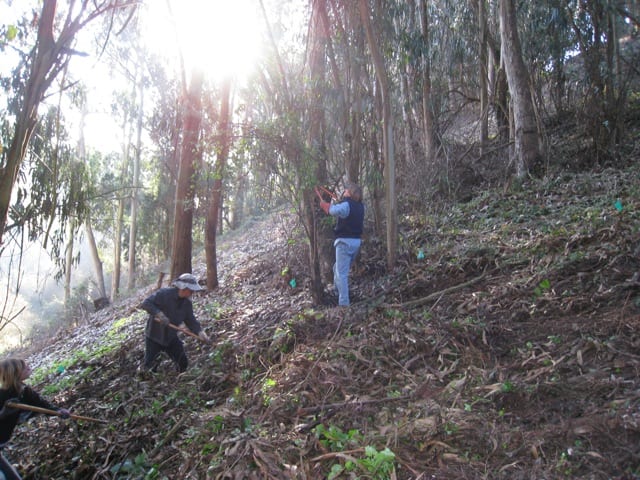
By Murray Schneider
Willow Creek Trail isn’t named on any official map that San Francisco Rec and Park has shelved at McLaren Lodge. Nevertheless, the Glen Canyon path circles Glen Park’s Islais Creek. It begins near a boardwalk that leaves Silver Tree Day Camp in its wake, runs parallel to a seep that collects run-off water from Diamond Heights and continues beneath canopies of arroyo willow and solitary strands of California blackberry that dangle like errant embroidery from a quilter’s needle.
Angling left, it passes over a railroad-tie-sized-chunk of wood acting as a single-file bridge above a nascent puddle yet to turn into succulent mud. Then, on the west side of the creek, it inches past invasive Himalayan blackberry whose stalks are pregnant with spiky thorns. Finally, the trail moves past beds of reintroduced native plants whose purpose is less aesthetic or nostalgic than it is to promote habitat diversity in San Francisco’s bucolic 70-acres natural area.
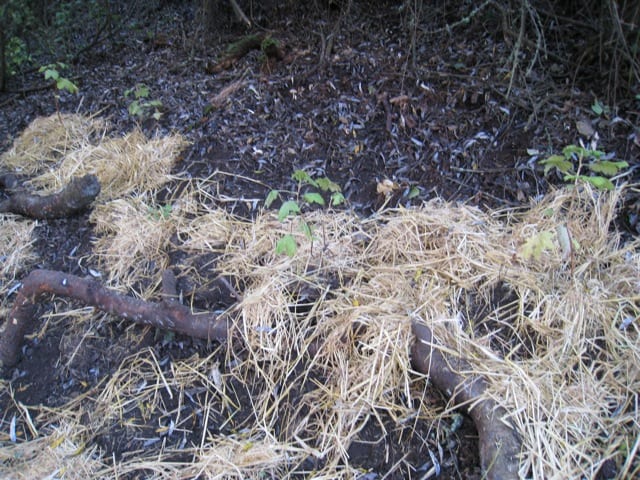
On the Wednesday before Christmas, Dylan Hayes, 40, a Rec and Park Natural Areas gardener, stood near a bank of Islais Creek, on the west side of a cedar-rail fence constructed by Friends of Glen Canyon Park, studying pink-flowering currant and columbine, both planted only three days earlier by volunteers from the same organization who built the split-rail fence three years ago.
The plants were thirsty, parched from the absence of December rains. “We’re interested in a variety of shrubs that are links in the food chain,” Hayes said. He pointed to dozens of plants, each surrounded by protective blankets of straw, which are designed to suppress weeds and to keep the dry soil moist. Both the columbine and pink-flowering currant hugged an incline that would eventually climb to the O’Shaughnessy Boulevard frontier. Kneeling down, Hayes brushed away some straw and fingered a stem of columbine. “It’s great food for moths, beetles and caterpillars.”
Hayes dressed in a fleece vest over a maroon long-sleeved T-shirt, both embossed with patented Rec and Park logos. Bright and crisp, the early morning signaled a chill. He wore Wellingtons since earlier he’d dredged pools of slow-moving water, like a mid-western kettle hole, above the seep from where wildlife drink, clearing it of choked detritus, making it user friendly for critters such as raccoons and coyotes.
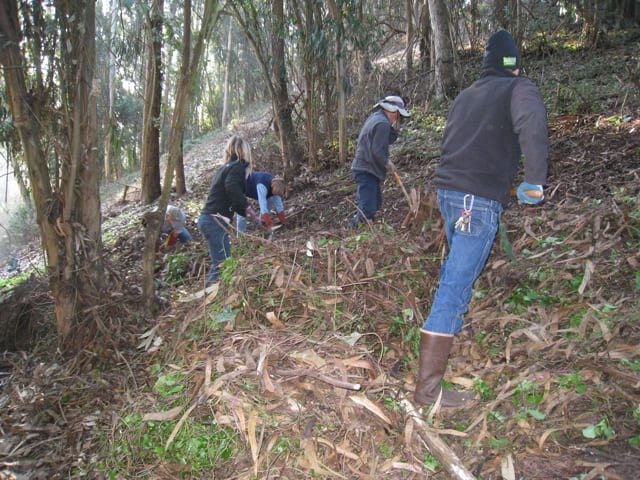
“The chorus frog drinks from up there,” Hayes said, pointing to the tawny hillside on the other side of the creek where amphibians croak springtime medleys of mating songs.
He continued to gesture to the hummock above the seep, home to hillside oaks from where red-tailed hawks hunt, their sharp eyes zeroing in on rodents coyotes may have overlooked.
“I call the pools the coyote baths,” he said. He fished an iPhone from his Levi’s and tapped an icon. A video of a grazing coyote appeared on the screen. The animal stretched and began moving at a snail’s pace toward the water hole.
“Coyotes are omnivores,” he said, pocketing his phone, “requiring a daily diet of voles, gophers and berries to maintain their mass.” Hayes has worked for the Natural Areas program for seven years, and it doesn’t take much prompting for him to stop what he’s doing and offer a mini-lecture on the ecology he’s entrusted to safeguard. His Recreation and Park Commission mandate is that of a steward of the Glen Canyon. He takes his empowerment seriously, ensuring the canyon’s preservation and assuring that day users have access to it, using it in symbiotic harmony with indigenous habitat, both plant and animal.
As the sun peeked through willow branches sheltering song birds, he tutored a Friends of Glen Canyon Park volunteer, demonstrating how best to sculpt berms that surround each native plant and then douse each with correct amounts of water. “Work your way down the line,” he instructed, “and then give them a second and third drink.”
The volunteer scooped ladles of water from a five-gallon container and anointed each plant, the liquid soon absorbed by the dry ground. “When the flowers bloom they become nectar to humming birds,” said Hayes, sounding every bit like a high school sophomore biology teacher. “In the winter, honey bees like them, too.”
He walked along the remaining reaches of Willow Creek Trail where Silver Tree’s bunker-like building hulked in front of him. Integrated among tall redwoods, a stand of eucalyptus trees towered in craggy spires, their deciduous leaf duff snapping under foot. The non-native gum tree, brought to California in the aftermath of the Gold Rush, has become an adoptive sibling to native conifers, its pungent perfume ingratiating itself to generations San Franciscans who have grown up surrounded by these giant Australian imports while rounding the western edges of Golden Gate Park and hiking atop Mt. Davidson.
But the shallow-rooted eucys need caretaking. Hayes pointed to a limb that crackled. It hung where Glenridge nursery school children, now on Christmas holiday, normally play. A similar Sigmund Stern Grove branch fell years before, causing the death a gardener. When branches fall along Willow Creek Trial they drop almost in slow motion, cracking from the girth of the tree, echoing like lightening in a thunderstorm.
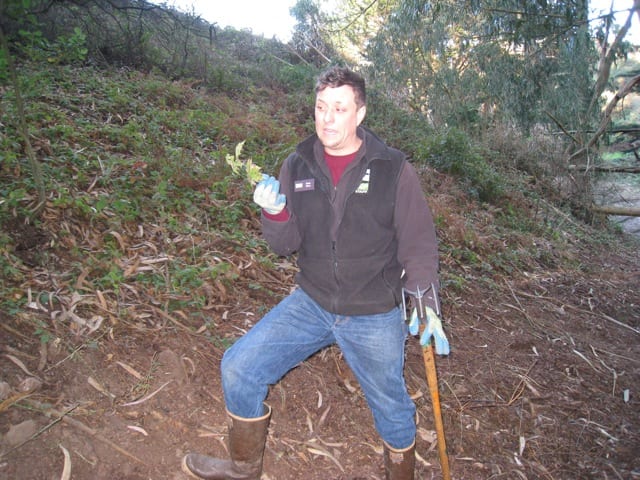
“We’re all about habitat diversity,” Hayes said. “We aren’t about wholesale tree removal, simply managing them.” He detoured above Silver Tree’s cement picnic benches where six volunteers worked, ankle deep in colonizing Cape ivy. Using three-pronged rakes, they muscled wide swaths of the invasive plant into mounds, making skirmish lines much like fire fighters do when they combat wilderness blazes.
They wrestled with pyramids of ivy, forming scrum lines in an effort to shoulder the inimical ivy up the hill. “Many hands makes light work,” Hayes said, reminded that the underfunded Natural Areas Program relies upon volunteers.
Critics of the Natural Area Program see its efforts as destructive to animal habitat, where pruning a willow branch is akin to clear-cutting a forest, where the occasional use of multi-faceted integrated pest management is tantamount to wholesale and irresponsible herbicide saturation.
NAP sees natural areas not as battlegrounds but natural park grounds, multi-use venues where wildlife, plants and people co-exist in symmetry. “Cape Ivy is a monoculture all to itself; it expands and threatens other species,” Hayes said.
He pointed up the hill to a variety of native shrubs. “All of that,” he said, in a calm and measured tone, “that’s monkey flower, coffee berry, hillside pea, elderberry, California blackberry two species of fern, even coast-live oak.”
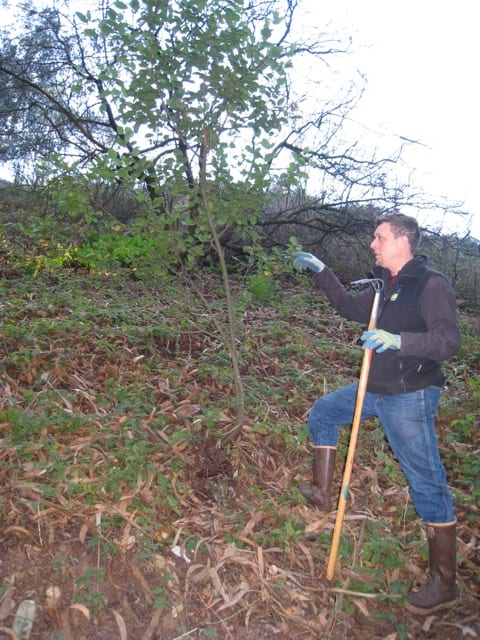
Left to its own devices, carpets of Cape ivy will spread amoeba-like, ascending the hill, strangling trees in its path, enveloping species after species. “What we’re doing is defending an intact food matrix,” Hayes said. “We’re clearing a defensive area, creating a barrier to prevent the continued encroachment of the ivy.”
Native to South Africa, Cape ivy has the ability to form a dense ground cover, climb trees and fences and other plants in such masses of herbaceous growth that it smothers everything beneath it.
Hayes leaned over and picked up a stem of ivy, appraised it and tossed it onto the burgeoning pile of its brethren. “We’re banking on short-term disturbance,” he said, “for long-term multi-purpose gain.”
If anyone has a long-term view of Glen Canyon it is Carol Steiman who, with her husband Harvey, has lived at the end of Bosworth Street for 27 years. Remembering it as dark, dank and barely accessible nearly three decades ago, today they both routinely walk its paths, just as likely to come across Hayes’s City utility truck, as they are other day-trippers, dog walkers and rock climbers.
“It is much more accessible, much more cared for now,” said Carol Steiman, who registered her daughter, Kate, at Silver Tree Day Camp 20 years ago. “Now I see people sitting on boulders and walking deep into the canyon.”
Hayes looked up from a California blackberry leaf he’d inspected, holding it up for a volunteer’s perusal, studying where both larvae and adult insects fed on the leaf.
“Insects sustain themselves from it,” he said, in his best professorial voice, “but just as importantly, it produces some of the best bird habitat by providing deep cover that the they need for nesting.”
He looked back at a cluster of eucalyptus trees. “Blackberry scrub is another habitat shaded out by eucalyptus groves that are unmanaged,” he cautioned. “This allows the Cape ivy to proliferate, shading out any possibility of plant species living together to form a strong local food web.”
Across the creek he watched a column of children bookended by adults. They trooped Indian-file along a path where earlier he’d encountered the lounging coyote. Several of the children skipped and hopped, more than enough proof that Glen Canyon is a sanctuary not simply for shrubs and wildlife, its original inhabitants, but for the next generation who will share it with them.
Dylan Hayes, the father of a soon to be two-year old daughter, grinned at the tableau playing out before him. “I like seeing that.”
Photos by Murray Schneider
====
Anyone wishing to volunteer in Glen Canyon can contact Joel Grey, volunteer coordinator, at Joe.Grey@sfgov.org or at 415-831-6328.